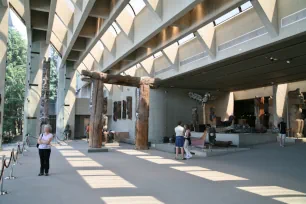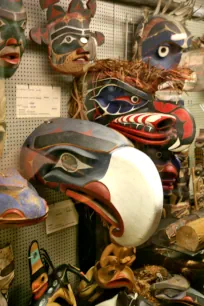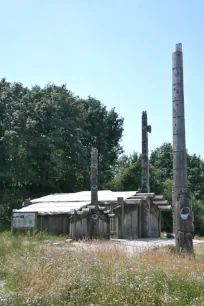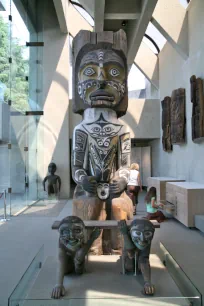The Museum of Anthropology is dedicated to the culture of the aboriginals of the Pacific Northwest, and in particular of the Haida. Thanks to its rich collection, it is the most interesting museum in Vancouver. If you only have time to see one museum in Vancouver, this is the one to visit!

Overview
Part of the University of British Columbia, the Museum of Anthropology is a gem inside and out. As you enter its massive carved-wood doors and make your way to the Great Hall, where the tall glass walls overlook the cliffs of Point Grey, you’ll know this museum is well worth the time it takes to explore.
The Building
The ethnographic collection of the University of British Columbia started in 1927 with just a few objects and for many years, no real museum building was deemed necessary to store the objects. Finally, in 1971, the Federal Government set aside a grant for a dedicated museum building.

Local architect Arthur Charles Erickson was chosen to design the museum, and he came up with an innovative spacious building, inspired by the dwellings of the aboriginal peoples. Its open layout makes this an easy and pleasant museum to navigate.



Collection
Vancouver’s Museum of Anthropology (MOA) has one of the most extensive collections of anthropological items and artifacts in the world and has distinguished itself among museums of its kind. The museum owns some 500,000 archaeological objects and 35,000 ethnographic pieces.
Permanent exhibits include an excellent one on the First Nations of Coastal British Columbia, which is where the emphasis of this museum lies. That collection alone consists of more than 6,000 objects.
The ethnographic objects, many of them one-of-a-kind, have been collected from literally all over the world. While these are not all displayed all at one time, the museum is diligent about changing exhibits often in order to take advantage of their vast collection.
Exhibits
After entering the museum, a walkway known as the Ramp leads to the Great Hall. The Ramp displays many large objects from the cedar plank houses of British Columbia’s aboriginal peoples, including decorative carvings, structural beams and totem poles. The collection is arranged by culture area.
The Ramp leads to the 15 m. (49 ft.) high Great Hall, the centerpiece of the museum, where even larger objects are displayed, including many tall totem poles. Besides historic objects, there are also impressive contemporary sculptures on display.
From inside the Great Hall, you can see reconstructed Haida houses, built outside on the museum grounds.
MOA’s Fiftieth Anniversary Gallery is home to a unique display of Northwest Coast art, past and present, and the museum’s Visible Storage Gallery allows the public to view more than 13,000 objects from the permanent collection, including not only First Nation artifacts but also objects from the Mediterranean, Africa, Indonesia, China, Oceania, India, Central America, Japan, and other parts of the world.
The Raven and the First Men

One of the museum’s highlights is a contemporary sculpture created by the late Haida craftsman Bill Reid: the Raven and the First Men. The sculpture, which has become one of Vancouver’s most important symbols, is located at the center of a rotunda.
It depicts the Haida legend that tells the story of the beginning of mankind. According to the story (or at least one of several versions), life started when a raven flew from heaven towards the earth and found the earth covered in snow. He then stole the sun from the gods and created animals, forests, rivers and oceans. One day, on a beach, the raven found an enormous clamshell with five men in it. The raven coaxed them into leaving the shell with the promise of a prosperous life. Hesitant at first, they eventually emerged from the shell, becoming the first Haida men. Eventually, the raven told them where to find women.

